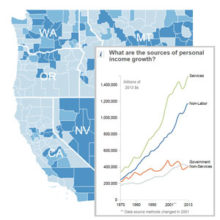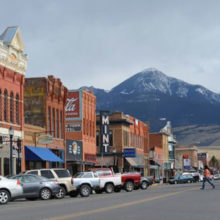One of the biggest challenges facing rural Western counties today is keeping and attracting youth, who help maintain population, keep schools open, and provide the workforce and customers needed to sustain local businesses.
As the interactive map immediately below shows, almost all western metro counties either are holding steady or gaining population from the in-migration of those aged 39 and under. Not surprisingly, the share of westerners living in urban areas is growing and is higher than the rest of the country. [Note: analysis requires decennial Census information to show age cohorts.]
Much of the gain in metro areas is due to an exodus of youth from rural areas. Rural areas such as eastern Montana and parts of New Mexico, by comparison, often are struggling to attract new residents and sustain population overall.
Youth Migration in the West
As the next interactive map shows, migration changes and trends are not permanent. Many counties have seen significant changes over time, as well as within specific age groups, as people respond to economic and cultural forces.
For example, across every decade Gallatin County, Montana has seen significant in-migration from both 0-19 year olds and 20-29 year olds, but out- migration from 30-39 year olds. Other counties like Boulder, Colorado and Benton, Oregon experienced similar results–and like Gallatin County both house large universities as well as significant retail and tourism sectors.
These counties are able to attract young adults, many of whom may stay after graduating but move away in their 30s due to relatively high cost of living or to seek a wider range of job opportunities.
In other places, like many counties in Wyoming, young working age populations fluctuate instead with the broader market changes in commodities like oil, gas, and coal.
Tracking and understanding why young people are moving in the West provides one significant insight into economic development.
One county’s migration or population boom, while another county declines, largely depends on the sectors driving the local economy and the type of workforce these sectors demand.
Working with Rural Western Communities
While the rural West has many valuable assets and great potential–such as the region’s high quality of life, community ties, and lower cost of living–many rural communities are facing significant social and economic challenges.
Unfortunately, current government and private sector approaches do not reflect current socioeconomic realities and often are failing rural citizens.
One of the most important issues requires improving human capital in rural communities through efforts such investing in rural education to keep and attract families or train workers.
Other steps include increasing the quality and availability of health care; expanding and upgrading infrastructure and communications networks to help rural communities more easily access larger markets; continuing agriculture programs such as the Farm Bill; and sustaining the quality of the landscape along with best practices for utilizing natural resources.
Some places are working to make themselves more attractive to younger generations. For example, the city of Rexburg in Madison County in eastern Idaho, is specifically targeting millennials in their economic development strategy in part by tapping into a strong entrepreneurial culture in this generation.
Going forward, updated, flexible, and varied policies will be necessary to provide rural towns and communities with the resources they need to keep their young residents and attract new ones, essential for competing in today’s economy.




